Property Pathway Programme: High Street Market and Yield Analysis
VerifiedAdded on 2023/06/13
|21
|5789
|259
Practical Assignment
AI Summary
This assignment involves a practical real estate market analysis, beginning with a hand-drawn sketch of a high street market, detailing occupiers, trade types, and vacant units. It then delves into property yield analysis, explaining the importance of yields in real estate valuation and how they reflect investor risk. The document discusses income yields, property-specific yields, and the factors influencing them, including risk, growth, and depreciation. An illustrative example demonstrates how to calculate property value based on net operating income and capitalization rates. Finally, the assignment covers term and reversion valuation, comparing fully let freeholds and reversionary freeholds, and providing an analysis of reversionary freehold value using the term and reversion approach. Desklib offers this assignment as a resource for students studying real estate, providing insights and solutions to enhance their understanding.
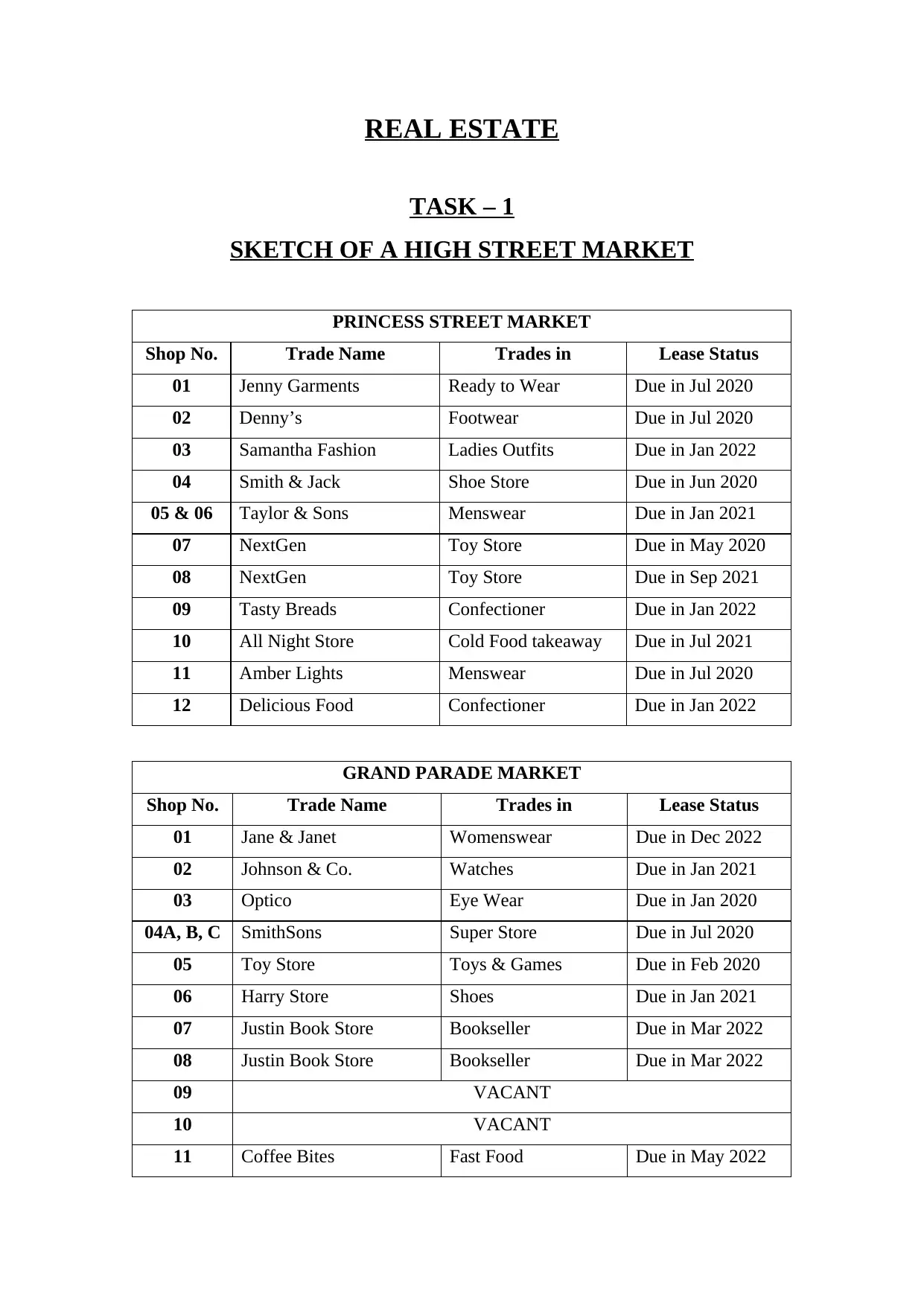
REAL ESTATE
TASK – 1
SKETCH OF A HIGH STREET MARKET
PRINCESS STREET MARKET
Shop No. Trade Name Trades in Lease Status
01 Jenny Garments Ready to Wear Due in Jul 2020
02 Denny’s Footwear Due in Jul 2020
03 Samantha Fashion Ladies Outfits Due in Jan 2022
04 Smith & Jack Shoe Store Due in Jun 2020
05 & 06 Taylor & Sons Menswear Due in Jan 2021
07 NextGen Toy Store Due in May 2020
08 NextGen Toy Store Due in Sep 2021
09 Tasty Breads Confectioner Due in Jan 2022
10 All Night Store Cold Food takeaway Due in Jul 2021
11 Amber Lights Menswear Due in Jul 2020
12 Delicious Food Confectioner Due in Jan 2022
GRAND PARADE MARKET
Shop No. Trade Name Trades in Lease Status
01 Jane & Janet Womenswear Due in Dec 2022
02 Johnson & Co. Watches Due in Jan 2021
03 Optico Eye Wear Due in Jan 2020
04A, B, C SmithSons Super Store Due in Jul 2020
05 Toy Store Toys & Games Due in Feb 2020
06 Harry Store Shoes Due in Jan 2021
07 Justin Book Store Bookseller Due in Mar 2022
08 Justin Book Store Bookseller Due in Mar 2022
09 VACANT
10 VACANT
11 Coffee Bites Fast Food Due in May 2022
TASK – 1
SKETCH OF A HIGH STREET MARKET
PRINCESS STREET MARKET
Shop No. Trade Name Trades in Lease Status
01 Jenny Garments Ready to Wear Due in Jul 2020
02 Denny’s Footwear Due in Jul 2020
03 Samantha Fashion Ladies Outfits Due in Jan 2022
04 Smith & Jack Shoe Store Due in Jun 2020
05 & 06 Taylor & Sons Menswear Due in Jan 2021
07 NextGen Toy Store Due in May 2020
08 NextGen Toy Store Due in Sep 2021
09 Tasty Breads Confectioner Due in Jan 2022
10 All Night Store Cold Food takeaway Due in Jul 2021
11 Amber Lights Menswear Due in Jul 2020
12 Delicious Food Confectioner Due in Jan 2022
GRAND PARADE MARKET
Shop No. Trade Name Trades in Lease Status
01 Jane & Janet Womenswear Due in Dec 2022
02 Johnson & Co. Watches Due in Jan 2021
03 Optico Eye Wear Due in Jan 2020
04A, B, C SmithSons Super Store Due in Jul 2020
05 Toy Store Toys & Games Due in Feb 2020
06 Harry Store Shoes Due in Jan 2021
07 Justin Book Store Bookseller Due in Mar 2022
08 Justin Book Store Bookseller Due in Mar 2022
09 VACANT
10 VACANT
11 Coffee Bites Fast Food Due in May 2022
Paraphrase This Document
Need a fresh take? Get an instant paraphrase of this document with our AI Paraphraser
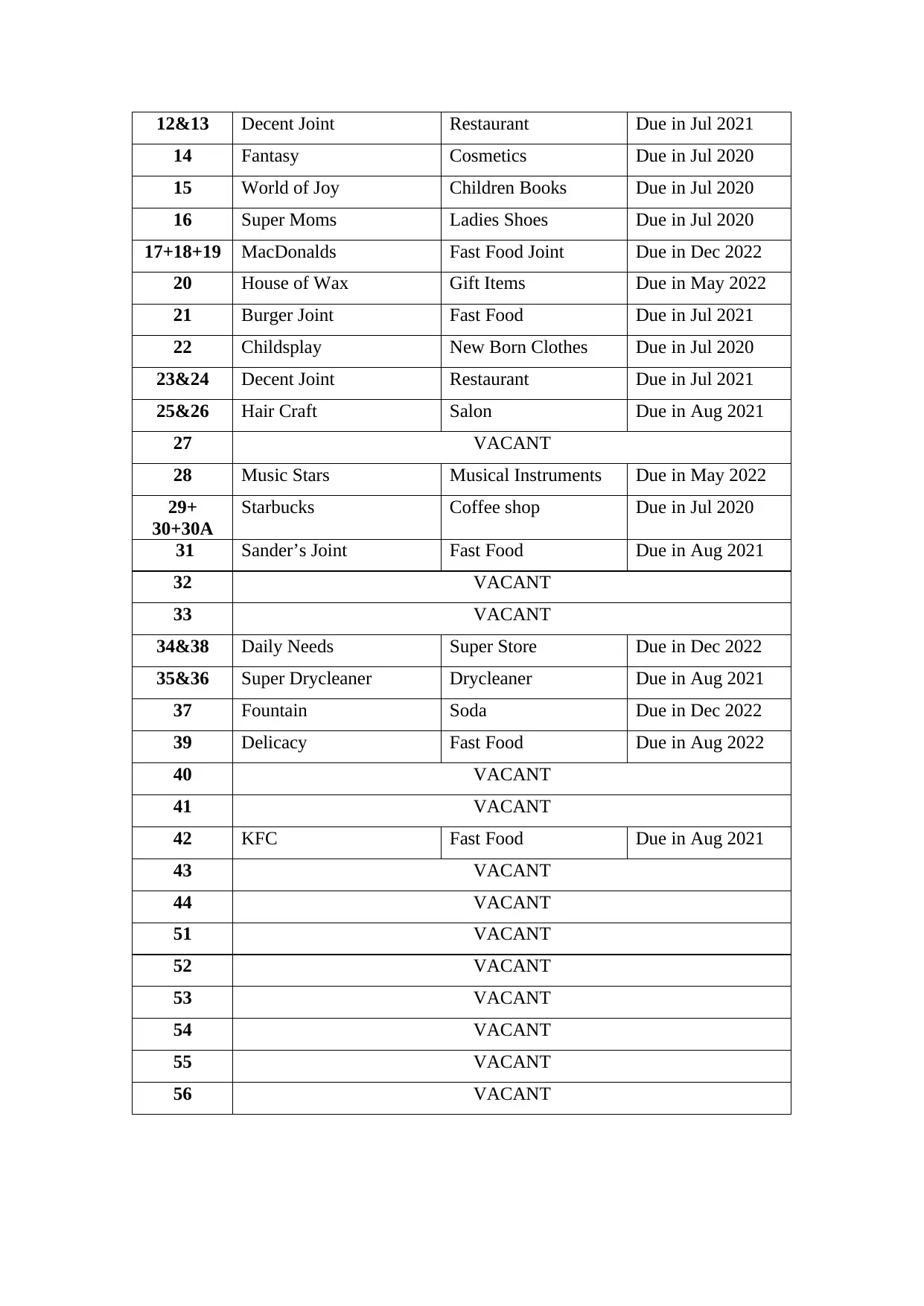
12&13 Decent Joint Restaurant Due in Jul 2021
14 Fantasy Cosmetics Due in Jul 2020
15 World of Joy Children Books Due in Jul 2020
16 Super Moms Ladies Shoes Due in Jul 2020
17+18+19 MacDonalds Fast Food Joint Due in Dec 2022
20 House of Wax Gift Items Due in May 2022
21 Burger Joint Fast Food Due in Jul 2021
22 Childsplay New Born Clothes Due in Jul 2020
23&24 Decent Joint Restaurant Due in Jul 2021
25&26 Hair Craft Salon Due in Aug 2021
27 VACANT
28 Music Stars Musical Instruments Due in May 2022
29+
30+30A
Starbucks Coffee shop Due in Jul 2020
31 Sander’s Joint Fast Food Due in Aug 2021
32 VACANT
33 VACANT
34&38 Daily Needs Super Store Due in Dec 2022
35&36 Super Drycleaner Drycleaner Due in Aug 2021
37 Fountain Soda Due in Dec 2022
39 Delicacy Fast Food Due in Aug 2022
40 VACANT
41 VACANT
42 KFC Fast Food Due in Aug 2021
43 VACANT
44 VACANT
51 VACANT
52 VACANT
53 VACANT
54 VACANT
55 VACANT
56 VACANT
14 Fantasy Cosmetics Due in Jul 2020
15 World of Joy Children Books Due in Jul 2020
16 Super Moms Ladies Shoes Due in Jul 2020
17+18+19 MacDonalds Fast Food Joint Due in Dec 2022
20 House of Wax Gift Items Due in May 2022
21 Burger Joint Fast Food Due in Jul 2021
22 Childsplay New Born Clothes Due in Jul 2020
23&24 Decent Joint Restaurant Due in Jul 2021
25&26 Hair Craft Salon Due in Aug 2021
27 VACANT
28 Music Stars Musical Instruments Due in May 2022
29+
30+30A
Starbucks Coffee shop Due in Jul 2020
31 Sander’s Joint Fast Food Due in Aug 2021
32 VACANT
33 VACANT
34&38 Daily Needs Super Store Due in Dec 2022
35&36 Super Drycleaner Drycleaner Due in Aug 2021
37 Fountain Soda Due in Dec 2022
39 Delicacy Fast Food Due in Aug 2022
40 VACANT
41 VACANT
42 KFC Fast Food Due in Aug 2021
43 VACANT
44 VACANT
51 VACANT
52 VACANT
53 VACANT
54 VACANT
55 VACANT
56 VACANT
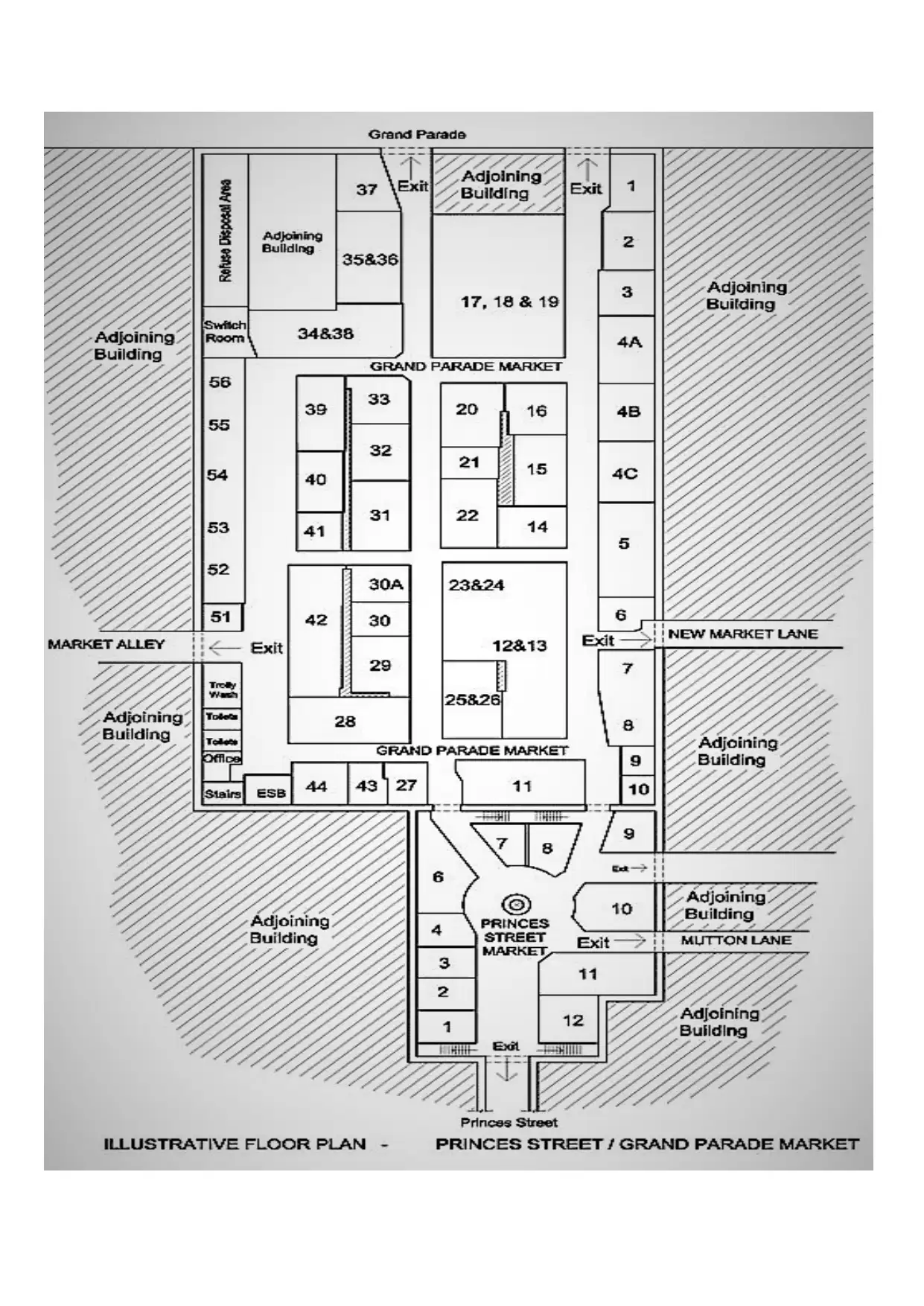
⊘ This is a preview!⊘
Do you want full access?
Subscribe today to unlock all pages.

Trusted by 1+ million students worldwide
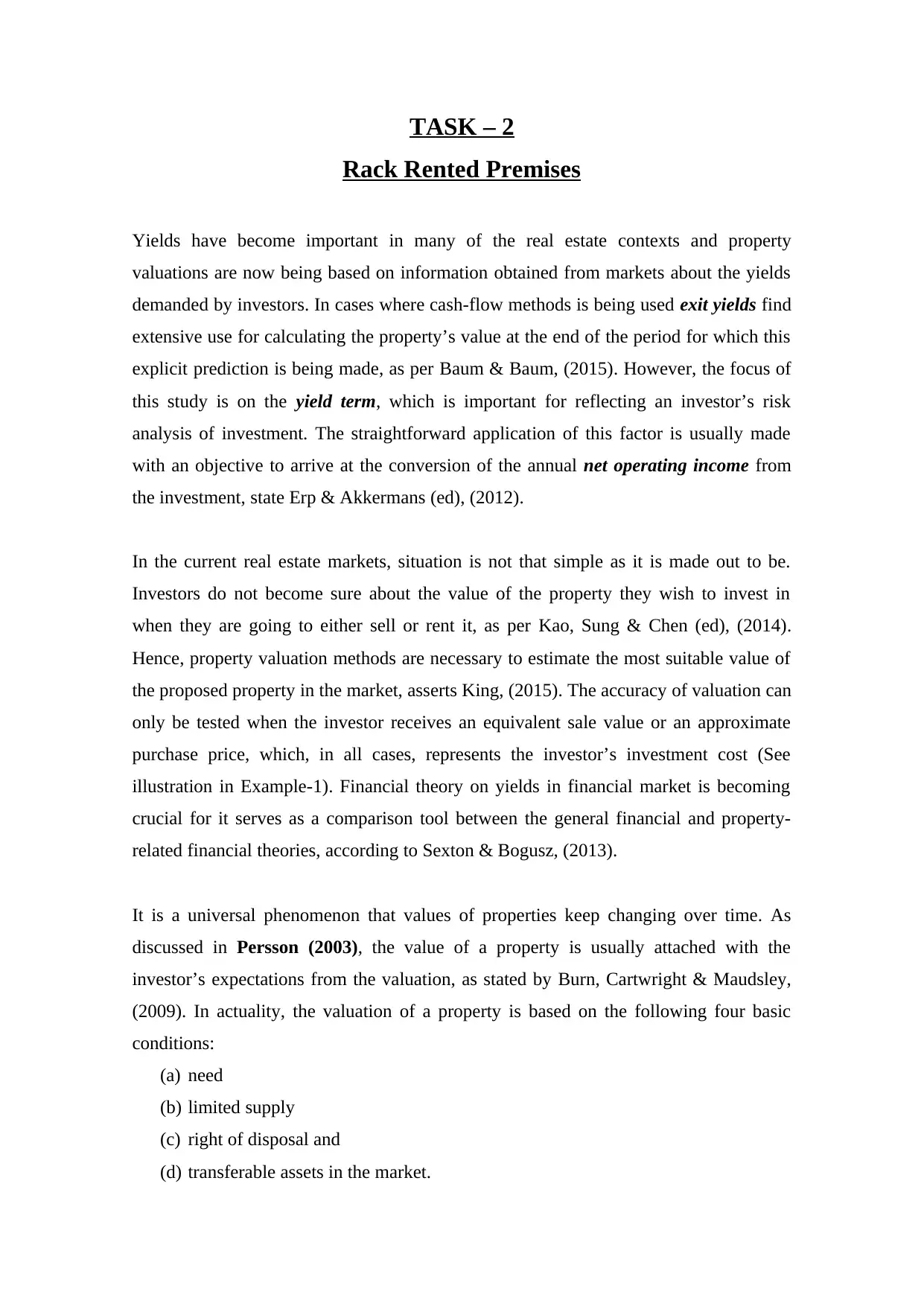
TASK – 2
Rack Rented Premises
Yields have become important in many of the real estate contexts and property
valuations are now being based on information obtained from markets about the yields
demanded by investors. In cases where cash-flow methods is being used exit yields find
extensive use for calculating the property’s value at the end of the period for which this
explicit prediction is being made, as per Baum & Baum, (2015). However, the focus of
this study is on the yield term, which is important for reflecting an investor’s risk
analysis of investment. The straightforward application of this factor is usually made
with an objective to arrive at the conversion of the annual net operating income from
the investment, state Erp & Akkermans (ed), (2012).
In the current real estate markets, situation is not that simple as it is made out to be.
Investors do not become sure about the value of the property they wish to invest in
when they are going to either sell or rent it, as per Kao, Sung & Chen (ed), (2014).
Hence, property valuation methods are necessary to estimate the most suitable value of
the proposed property in the market, asserts King, (2015). The accuracy of valuation can
only be tested when the investor receives an equivalent sale value or an approximate
purchase price, which, in all cases, represents the investor’s investment cost (See
illustration in Example-1). Financial theory on yields in financial market is becoming
crucial for it serves as a comparison tool between the general financial and property-
related financial theories, according to Sexton & Bogusz, (2013).
It is a universal phenomenon that values of properties keep changing over time. As
discussed in Persson (2003), the value of a property is usually attached with the
investor’s expectations from the valuation, as stated by Burn, Cartwright & Maudsley,
(2009). In actuality, the valuation of a property is based on the following four basic
conditions:
(a) need
(b) limited supply
(c) right of disposal and
(d) transferable assets in the market.
Rack Rented Premises
Yields have become important in many of the real estate contexts and property
valuations are now being based on information obtained from markets about the yields
demanded by investors. In cases where cash-flow methods is being used exit yields find
extensive use for calculating the property’s value at the end of the period for which this
explicit prediction is being made, as per Baum & Baum, (2015). However, the focus of
this study is on the yield term, which is important for reflecting an investor’s risk
analysis of investment. The straightforward application of this factor is usually made
with an objective to arrive at the conversion of the annual net operating income from
the investment, state Erp & Akkermans (ed), (2012).
In the current real estate markets, situation is not that simple as it is made out to be.
Investors do not become sure about the value of the property they wish to invest in
when they are going to either sell or rent it, as per Kao, Sung & Chen (ed), (2014).
Hence, property valuation methods are necessary to estimate the most suitable value of
the proposed property in the market, asserts King, (2015). The accuracy of valuation can
only be tested when the investor receives an equivalent sale value or an approximate
purchase price, which, in all cases, represents the investor’s investment cost (See
illustration in Example-1). Financial theory on yields in financial market is becoming
crucial for it serves as a comparison tool between the general financial and property-
related financial theories, according to Sexton & Bogusz, (2013).
It is a universal phenomenon that values of properties keep changing over time. As
discussed in Persson (2003), the value of a property is usually attached with the
investor’s expectations from the valuation, as stated by Burn, Cartwright & Maudsley,
(2009). In actuality, the valuation of a property is based on the following four basic
conditions:
(a) need
(b) limited supply
(c) right of disposal and
(d) transferable assets in the market.
Paraphrase This Document
Need a fresh take? Get an instant paraphrase of this document with our AI Paraphraser
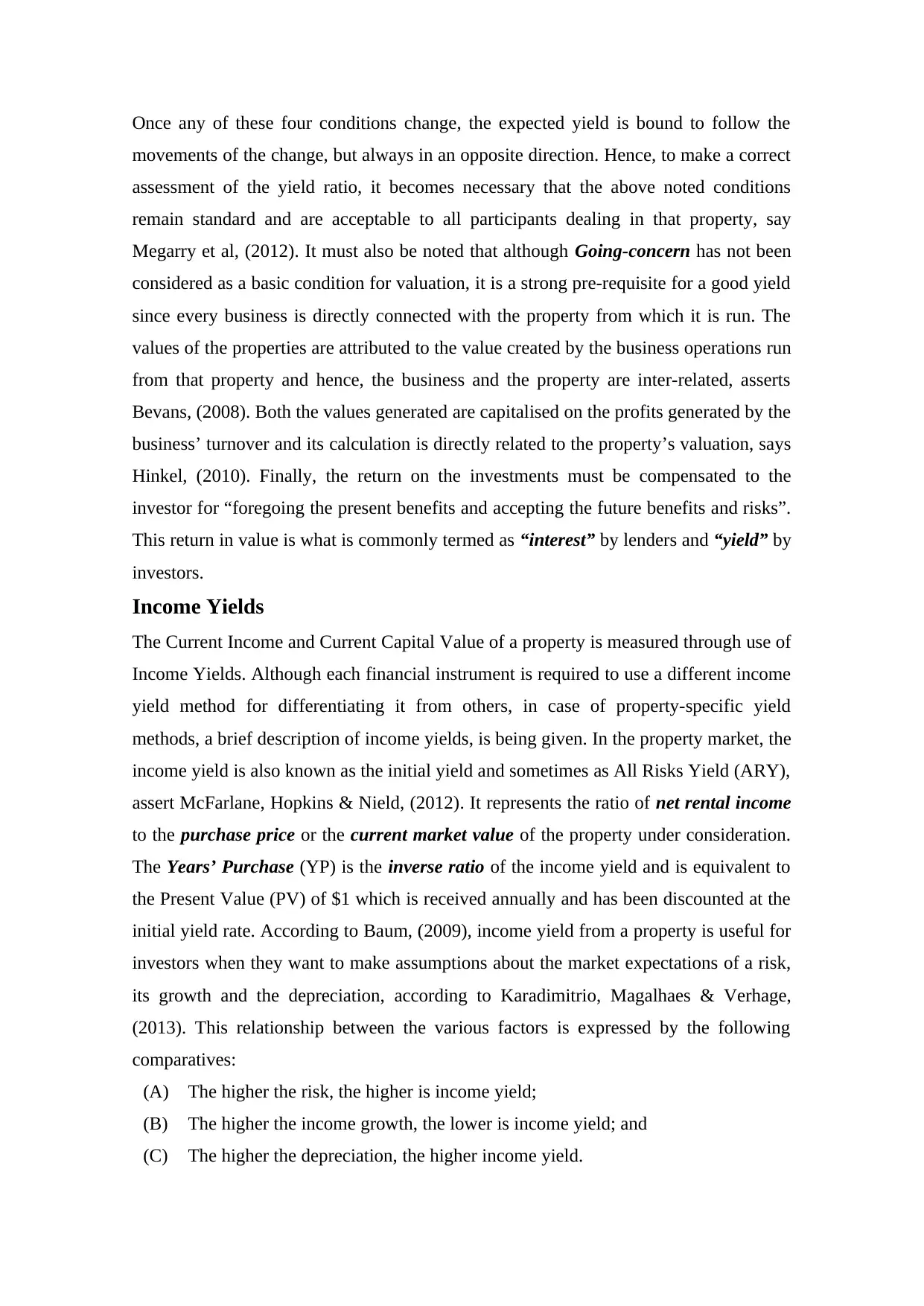
Once any of these four conditions change, the expected yield is bound to follow the
movements of the change, but always in an opposite direction. Hence, to make a correct
assessment of the yield ratio, it becomes necessary that the above noted conditions
remain standard and are acceptable to all participants dealing in that property, say
Megarry et al, (2012). It must also be noted that although Going-concern has not been
considered as a basic condition for valuation, it is a strong pre-requisite for a good yield
since every business is directly connected with the property from which it is run. The
values of the properties are attributed to the value created by the business operations run
from that property and hence, the business and the property are inter-related, asserts
Bevans, (2008). Both the values generated are capitalised on the profits generated by the
business’ turnover and its calculation is directly related to the property’s valuation, says
Hinkel, (2010). Finally, the return on the investments must be compensated to the
investor for “foregoing the present benefits and accepting the future benefits and risks”.
This return in value is what is commonly termed as “interest” by lenders and “yield” by
investors.
Income Yields
The Current Income and Current Capital Value of a property is measured through use of
Income Yields. Although each financial instrument is required to use a different income
yield method for differentiating it from others, in case of property-specific yield
methods, a brief description of income yields, is being given. In the property market, the
income yield is also known as the initial yield and sometimes as All Risks Yield (ARY),
assert McFarlane, Hopkins & Nield, (2012). It represents the ratio of net rental income
to the purchase price or the current market value of the property under consideration.
The Years’ Purchase (YP) is the inverse ratio of the income yield and is equivalent to
the Present Value (PV) of $1 which is received annually and has been discounted at the
initial yield rate. According to Baum, (2009), income yield from a property is useful for
investors when they want to make assumptions about the market expectations of a risk,
its growth and the depreciation, according to Karadimitrio, Magalhaes & Verhage,
(2013). This relationship between the various factors is expressed by the following
comparatives:
(A) The higher the risk, the higher is income yield;
(B) The higher the income growth, the lower is income yield; and
(C) The higher the depreciation, the higher income yield.
movements of the change, but always in an opposite direction. Hence, to make a correct
assessment of the yield ratio, it becomes necessary that the above noted conditions
remain standard and are acceptable to all participants dealing in that property, say
Megarry et al, (2012). It must also be noted that although Going-concern has not been
considered as a basic condition for valuation, it is a strong pre-requisite for a good yield
since every business is directly connected with the property from which it is run. The
values of the properties are attributed to the value created by the business operations run
from that property and hence, the business and the property are inter-related, asserts
Bevans, (2008). Both the values generated are capitalised on the profits generated by the
business’ turnover and its calculation is directly related to the property’s valuation, says
Hinkel, (2010). Finally, the return on the investments must be compensated to the
investor for “foregoing the present benefits and accepting the future benefits and risks”.
This return in value is what is commonly termed as “interest” by lenders and “yield” by
investors.
Income Yields
The Current Income and Current Capital Value of a property is measured through use of
Income Yields. Although each financial instrument is required to use a different income
yield method for differentiating it from others, in case of property-specific yield
methods, a brief description of income yields, is being given. In the property market, the
income yield is also known as the initial yield and sometimes as All Risks Yield (ARY),
assert McFarlane, Hopkins & Nield, (2012). It represents the ratio of net rental income
to the purchase price or the current market value of the property under consideration.
The Years’ Purchase (YP) is the inverse ratio of the income yield and is equivalent to
the Present Value (PV) of $1 which is received annually and has been discounted at the
initial yield rate. According to Baum, (2009), income yield from a property is useful for
investors when they want to make assumptions about the market expectations of a risk,
its growth and the depreciation, according to Karadimitrio, Magalhaes & Verhage,
(2013). This relationship between the various factors is expressed by the following
comparatives:
(A) The higher the risk, the higher is income yield;
(B) The higher the income growth, the lower is income yield; and
(C) The higher the depreciation, the higher income yield.
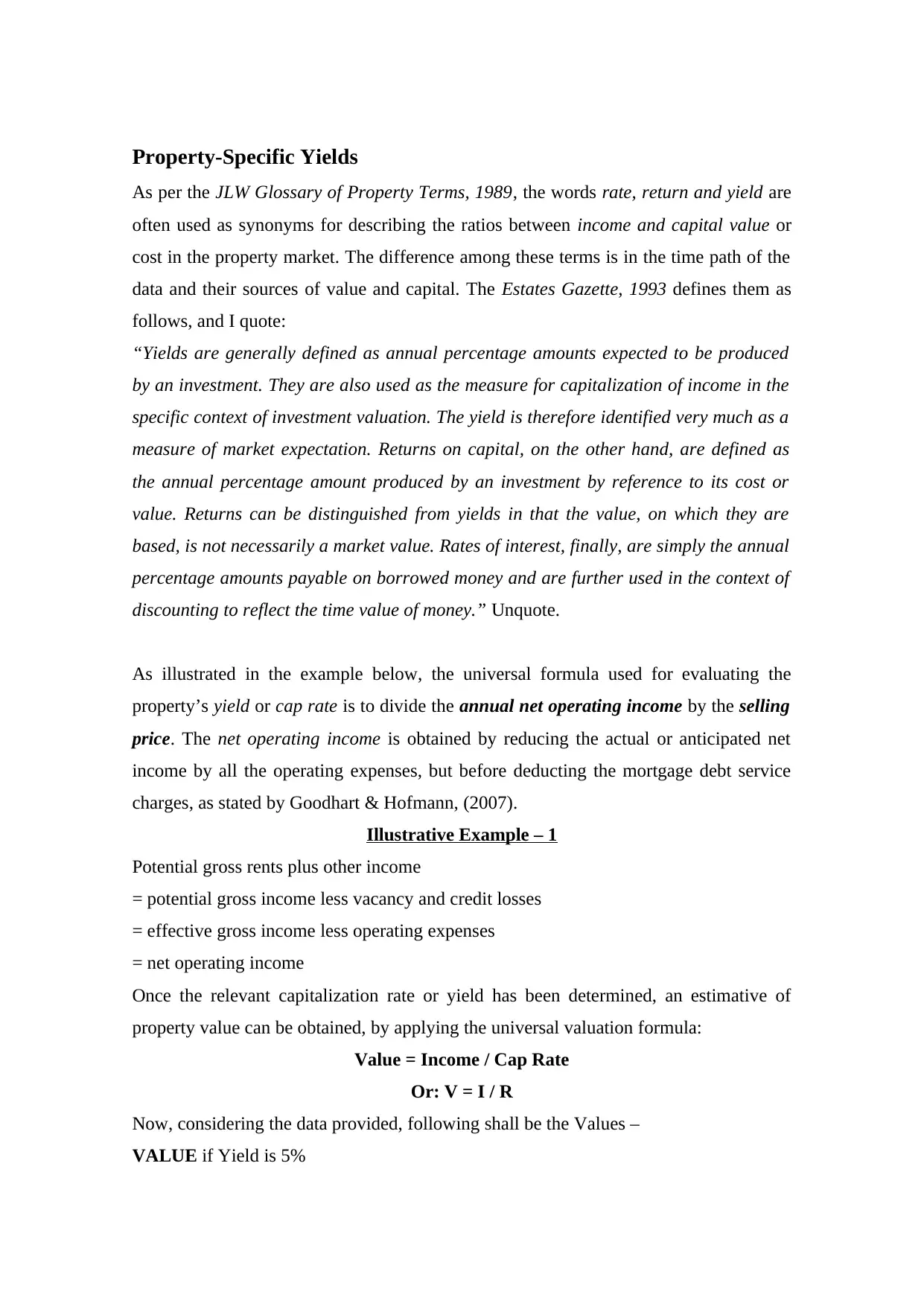
Property-Specific Yields
As per the JLW Glossary of Property Terms, 1989, the words rate, return and yield are
often used as synonyms for describing the ratios between income and capital value or
cost in the property market. The difference among these terms is in the time path of the
data and their sources of value and capital. The Estates Gazette, 1993 defines them as
follows, and I quote:
“Yields are generally defined as annual percentage amounts expected to be produced
by an investment. They are also used as the measure for capitalization of income in the
specific context of investment valuation. The yield is therefore identified very much as a
measure of market expectation. Returns on capital, on the other hand, are defined as
the annual percentage amount produced by an investment by reference to its cost or
value. Returns can be distinguished from yields in that the value, on which they are
based, is not necessarily a market value. Rates of interest, finally, are simply the annual
percentage amounts payable on borrowed money and are further used in the context of
discounting to reflect the time value of money.” Unquote.
As illustrated in the example below, the universal formula used for evaluating the
property’s yield or cap rate is to divide the annual net operating income by the selling
price. The net operating income is obtained by reducing the actual or anticipated net
income by all the operating expenses, but before deducting the mortgage debt service
charges, as stated by Goodhart & Hofmann, (2007).
Illustrative Example – 1
Potential gross rents plus other income
= potential gross income less vacancy and credit losses
= effective gross income less operating expenses
= net operating income
Once the relevant capitalization rate or yield has been determined, an estimative of
property value can be obtained, by applying the universal valuation formula:
Value = Income / Cap Rate
Or: V = I / R
Now, considering the data provided, following shall be the Values –
VALUE if Yield is 5%
As per the JLW Glossary of Property Terms, 1989, the words rate, return and yield are
often used as synonyms for describing the ratios between income and capital value or
cost in the property market. The difference among these terms is in the time path of the
data and their sources of value and capital. The Estates Gazette, 1993 defines them as
follows, and I quote:
“Yields are generally defined as annual percentage amounts expected to be produced
by an investment. They are also used as the measure for capitalization of income in the
specific context of investment valuation. The yield is therefore identified very much as a
measure of market expectation. Returns on capital, on the other hand, are defined as
the annual percentage amount produced by an investment by reference to its cost or
value. Returns can be distinguished from yields in that the value, on which they are
based, is not necessarily a market value. Rates of interest, finally, are simply the annual
percentage amounts payable on borrowed money and are further used in the context of
discounting to reflect the time value of money.” Unquote.
As illustrated in the example below, the universal formula used for evaluating the
property’s yield or cap rate is to divide the annual net operating income by the selling
price. The net operating income is obtained by reducing the actual or anticipated net
income by all the operating expenses, but before deducting the mortgage debt service
charges, as stated by Goodhart & Hofmann, (2007).
Illustrative Example – 1
Potential gross rents plus other income
= potential gross income less vacancy and credit losses
= effective gross income less operating expenses
= net operating income
Once the relevant capitalization rate or yield has been determined, an estimative of
property value can be obtained, by applying the universal valuation formula:
Value = Income / Cap Rate
Or: V = I / R
Now, considering the data provided, following shall be the Values –
VALUE if Yield is 5%
⊘ This is a preview!⊘
Do you want full access?
Subscribe today to unlock all pages.

Trusted by 1+ million students worldwide
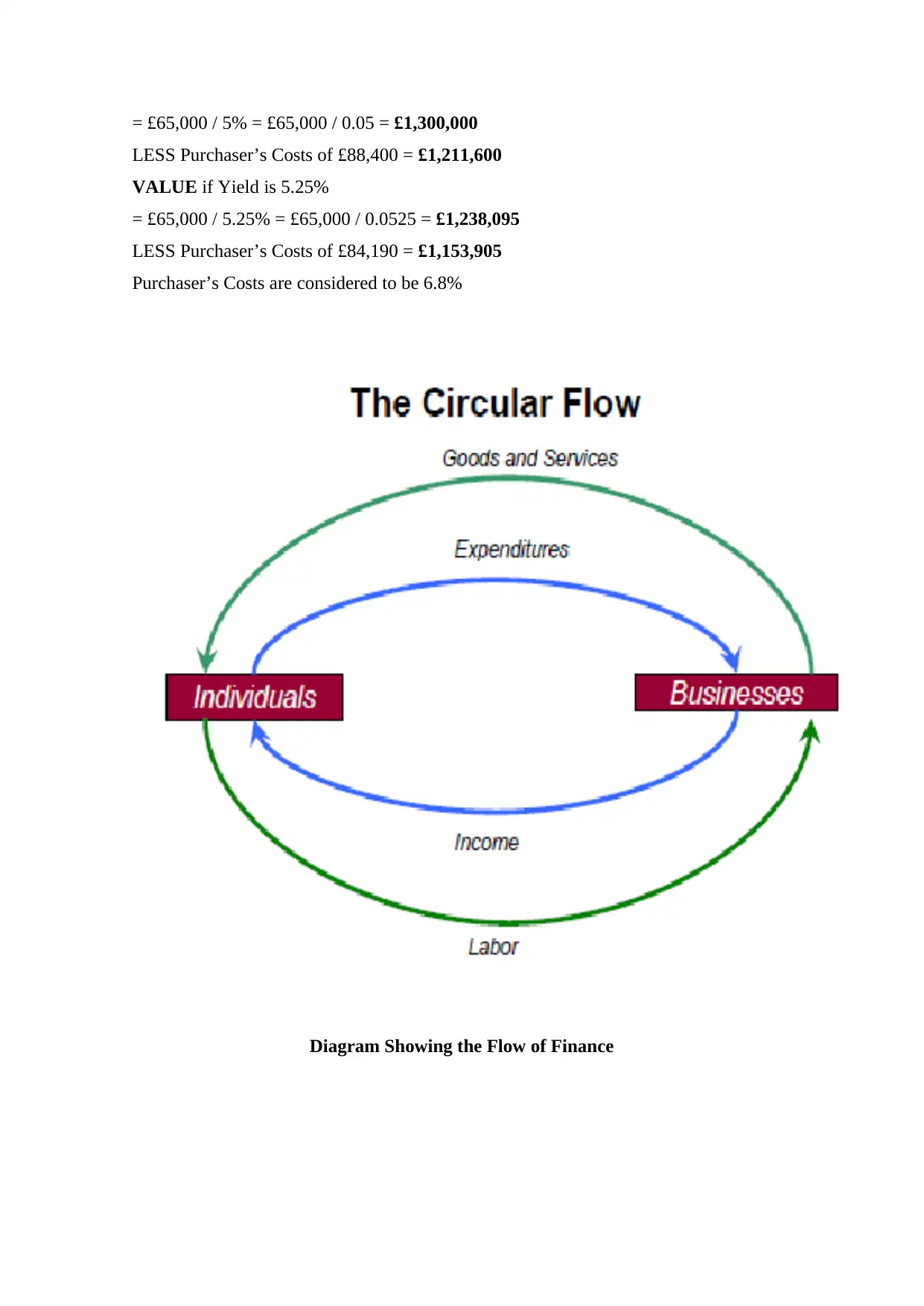
= £65,000 / 5% = £65,000 / 0.05 = £1,300,000
LESS Purchaser’s Costs of £88,400 = £1,211,600
VALUE if Yield is 5.25%
= £65,000 / 5.25% = £65,000 / 0.0525 = £1,238,095
LESS Purchaser’s Costs of £84,190 = £1,153,905
Purchaser’s Costs are considered to be 6.8%
Diagram Showing the Flow of Finance
LESS Purchaser’s Costs of £88,400 = £1,211,600
VALUE if Yield is 5.25%
= £65,000 / 5.25% = £65,000 / 0.0525 = £1,238,095
LESS Purchaser’s Costs of £84,190 = £1,153,905
Purchaser’s Costs are considered to be 6.8%
Diagram Showing the Flow of Finance
Paraphrase This Document
Need a fresh take? Get an instant paraphrase of this document with our AI Paraphraser
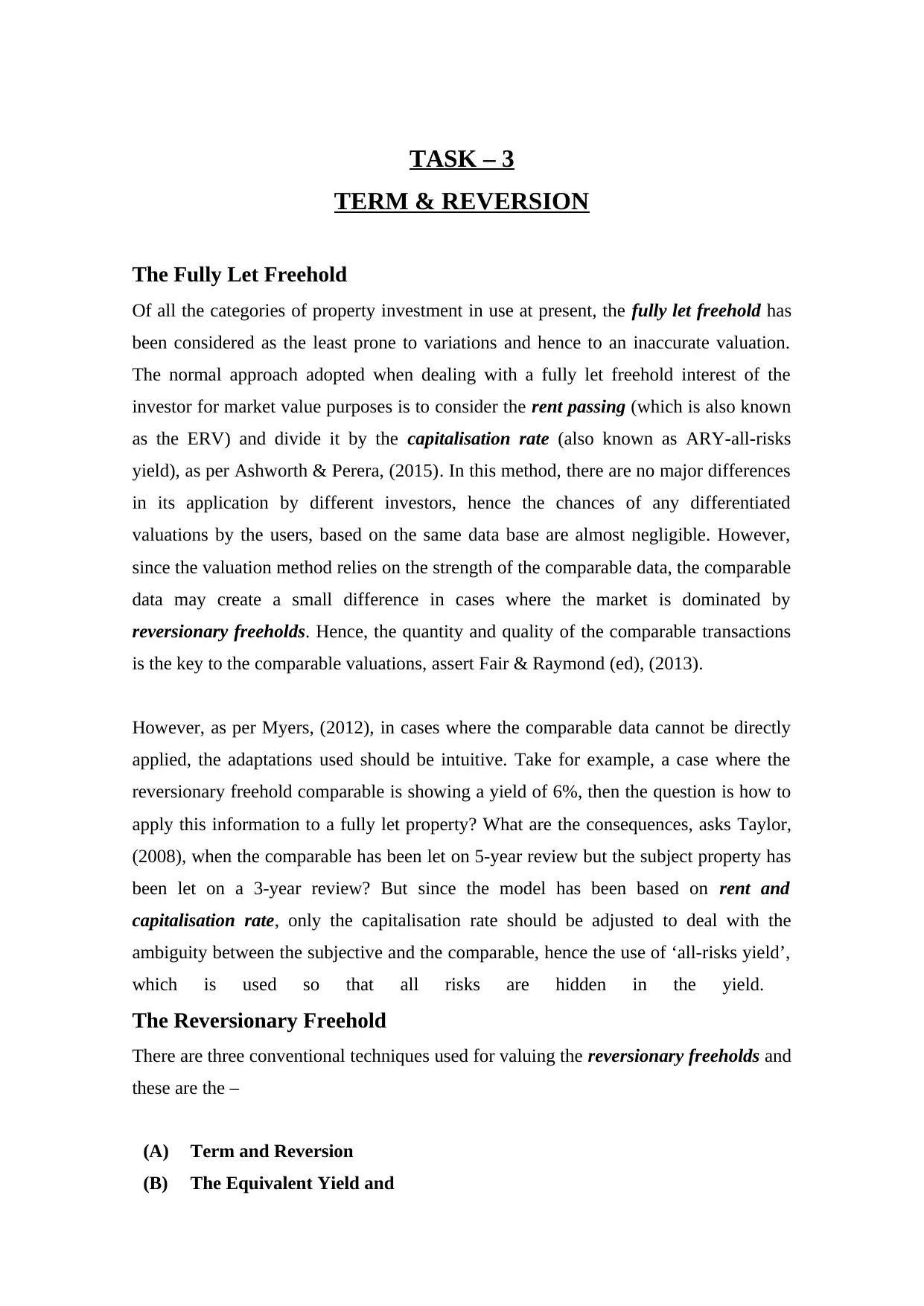
TASK – 3
TERM & REVERSION
The Fully Let Freehold
Of all the categories of property investment in use at present, the fully let freehold has
been considered as the least prone to variations and hence to an inaccurate valuation.
The normal approach adopted when dealing with a fully let freehold interest of the
investor for market value purposes is to consider the rent passing (which is also known
as the ERV) and divide it by the capitalisation rate (also known as ARY-all-risks
yield), as per Ashworth & Perera, (2015). In this method, there are no major differences
in its application by different investors, hence the chances of any differentiated
valuations by the users, based on the same data base are almost negligible. However,
since the valuation method relies on the strength of the comparable data, the comparable
data may create a small difference in cases where the market is dominated by
reversionary freeholds. Hence, the quantity and quality of the comparable transactions
is the key to the comparable valuations, assert Fair & Raymond (ed), (2013).
However, as per Myers, (2012), in cases where the comparable data cannot be directly
applied, the adaptations used should be intuitive. Take for example, a case where the
reversionary freehold comparable is showing a yield of 6%, then the question is how to
apply this information to a fully let property? What are the consequences, asks Taylor,
(2008), when the comparable has been let on 5-year review but the subject property has
been let on a 3-year review? But since the model has been based on rent and
capitalisation rate, only the capitalisation rate should be adjusted to deal with the
ambiguity between the subjective and the comparable, hence the use of ‘all-risks yield’,
which is used so that all risks are hidden in the yield.
The Reversionary Freehold
There are three conventional techniques used for valuing the reversionary freeholds and
these are the –
(A) Term and Reversion
(B) The Equivalent Yield and
TERM & REVERSION
The Fully Let Freehold
Of all the categories of property investment in use at present, the fully let freehold has
been considered as the least prone to variations and hence to an inaccurate valuation.
The normal approach adopted when dealing with a fully let freehold interest of the
investor for market value purposes is to consider the rent passing (which is also known
as the ERV) and divide it by the capitalisation rate (also known as ARY-all-risks
yield), as per Ashworth & Perera, (2015). In this method, there are no major differences
in its application by different investors, hence the chances of any differentiated
valuations by the users, based on the same data base are almost negligible. However,
since the valuation method relies on the strength of the comparable data, the comparable
data may create a small difference in cases where the market is dominated by
reversionary freeholds. Hence, the quantity and quality of the comparable transactions
is the key to the comparable valuations, assert Fair & Raymond (ed), (2013).
However, as per Myers, (2012), in cases where the comparable data cannot be directly
applied, the adaptations used should be intuitive. Take for example, a case where the
reversionary freehold comparable is showing a yield of 6%, then the question is how to
apply this information to a fully let property? What are the consequences, asks Taylor,
(2008), when the comparable has been let on 5-year review but the subject property has
been let on a 3-year review? But since the model has been based on rent and
capitalisation rate, only the capitalisation rate should be adjusted to deal with the
ambiguity between the subjective and the comparable, hence the use of ‘all-risks yield’,
which is used so that all risks are hidden in the yield.
The Reversionary Freehold
There are three conventional techniques used for valuing the reversionary freeholds and
these are the –
(A) Term and Reversion
(B) The Equivalent Yield and
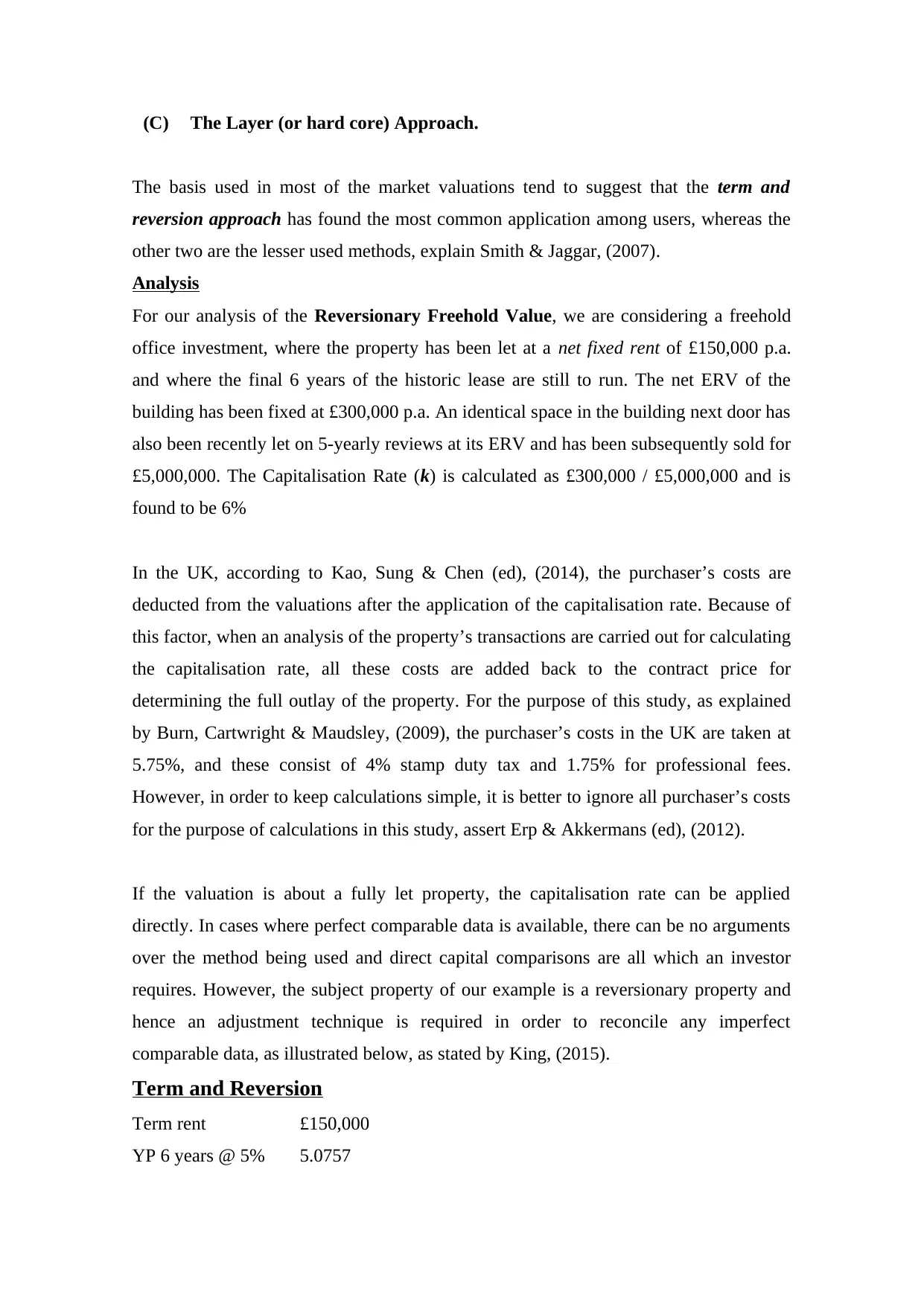
(C) The Layer (or hard core) Approach.
The basis used in most of the market valuations tend to suggest that the term and
reversion approach has found the most common application among users, whereas the
other two are the lesser used methods, explain Smith & Jaggar, (2007).
Analysis
For our analysis of the Reversionary Freehold Value, we are considering a freehold
office investment, where the property has been let at a net fixed rent of £150,000 p.a.
and where the final 6 years of the historic lease are still to run. The net ERV of the
building has been fixed at £300,000 p.a. An identical space in the building next door has
also been recently let on 5-yearly reviews at its ERV and has been subsequently sold for
£5,000,000. The Capitalisation Rate (k) is calculated as £300,000 / £5,000,000 and is
found to be 6%
In the UK, according to Kao, Sung & Chen (ed), (2014), the purchaser’s costs are
deducted from the valuations after the application of the capitalisation rate. Because of
this factor, when an analysis of the property’s transactions are carried out for calculating
the capitalisation rate, all these costs are added back to the contract price for
determining the full outlay of the property. For the purpose of this study, as explained
by Burn, Cartwright & Maudsley, (2009), the purchaser’s costs in the UK are taken at
5.75%, and these consist of 4% stamp duty tax and 1.75% for professional fees.
However, in order to keep calculations simple, it is better to ignore all purchaser’s costs
for the purpose of calculations in this study, assert Erp & Akkermans (ed), (2012).
If the valuation is about a fully let property, the capitalisation rate can be applied
directly. In cases where perfect comparable data is available, there can be no arguments
over the method being used and direct capital comparisons are all which an investor
requires. However, the subject property of our example is a reversionary property and
hence an adjustment technique is required in order to reconcile any imperfect
comparable data, as illustrated below, as stated by King, (2015).
Term and Reversion
Term rent £150,000
YP 6 years @ 5% 5.0757
The basis used in most of the market valuations tend to suggest that the term and
reversion approach has found the most common application among users, whereas the
other two are the lesser used methods, explain Smith & Jaggar, (2007).
Analysis
For our analysis of the Reversionary Freehold Value, we are considering a freehold
office investment, where the property has been let at a net fixed rent of £150,000 p.a.
and where the final 6 years of the historic lease are still to run. The net ERV of the
building has been fixed at £300,000 p.a. An identical space in the building next door has
also been recently let on 5-yearly reviews at its ERV and has been subsequently sold for
£5,000,000. The Capitalisation Rate (k) is calculated as £300,000 / £5,000,000 and is
found to be 6%
In the UK, according to Kao, Sung & Chen (ed), (2014), the purchaser’s costs are
deducted from the valuations after the application of the capitalisation rate. Because of
this factor, when an analysis of the property’s transactions are carried out for calculating
the capitalisation rate, all these costs are added back to the contract price for
determining the full outlay of the property. For the purpose of this study, as explained
by Burn, Cartwright & Maudsley, (2009), the purchaser’s costs in the UK are taken at
5.75%, and these consist of 4% stamp duty tax and 1.75% for professional fees.
However, in order to keep calculations simple, it is better to ignore all purchaser’s costs
for the purpose of calculations in this study, assert Erp & Akkermans (ed), (2012).
If the valuation is about a fully let property, the capitalisation rate can be applied
directly. In cases where perfect comparable data is available, there can be no arguments
over the method being used and direct capital comparisons are all which an investor
requires. However, the subject property of our example is a reversionary property and
hence an adjustment technique is required in order to reconcile any imperfect
comparable data, as illustrated below, as stated by King, (2015).
Term and Reversion
Term rent £150,000
YP 6 years @ 5% 5.0757
⊘ This is a preview!⊘
Do you want full access?
Subscribe today to unlock all pages.

Trusted by 1+ million students worldwide
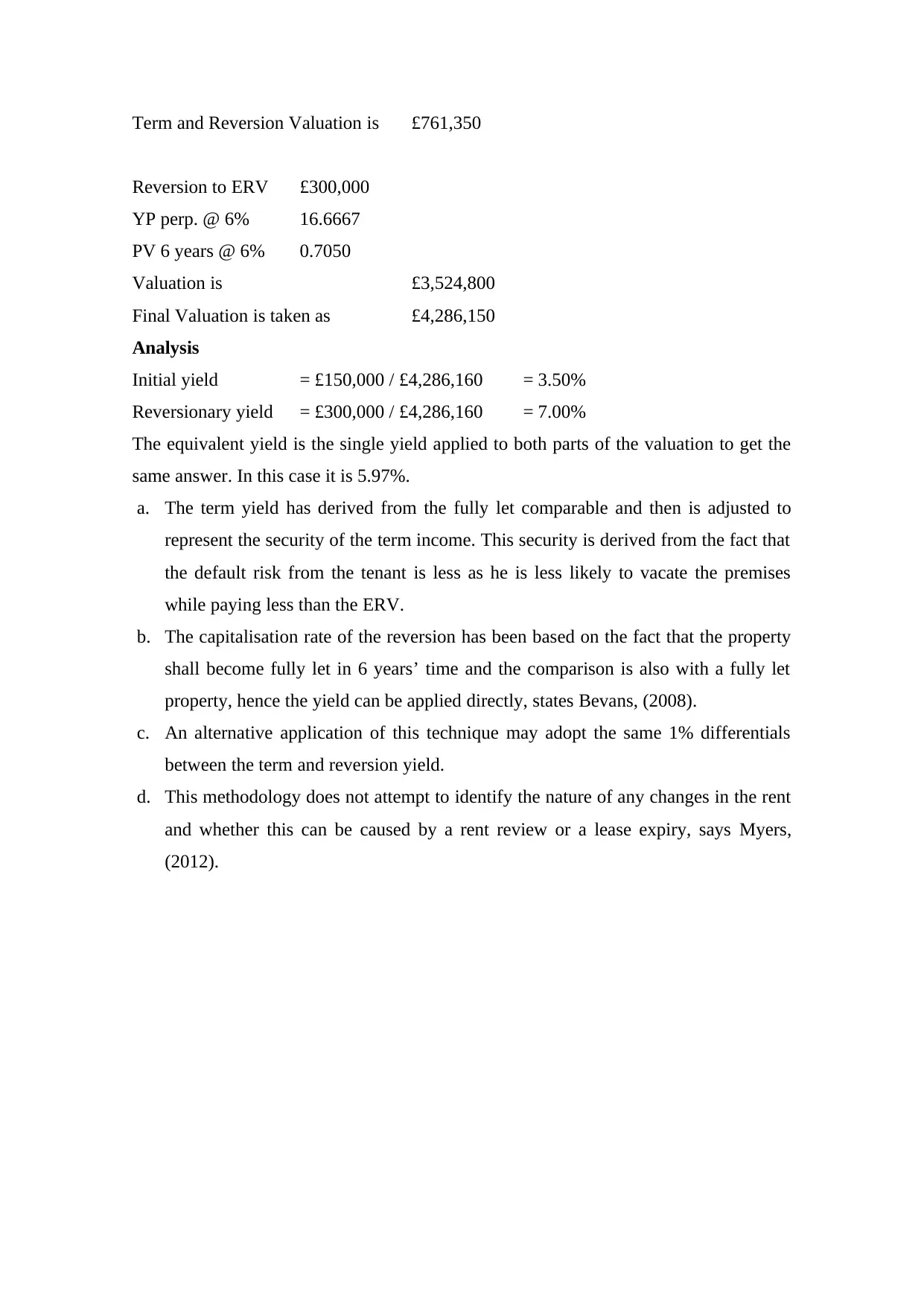
Term and Reversion Valuation is £761,350
Reversion to ERV £300,000
YP perp. @ 6% 16.6667
PV 6 years @ 6% 0.7050
Valuation is £3,524,800
Final Valuation is taken as £4,286,150
Analysis
Initial yield = £150,000 / £4,286,160 = 3.50%
Reversionary yield = £300,000 / £4,286,160 = 7.00%
The equivalent yield is the single yield applied to both parts of the valuation to get the
same answer. In this case it is 5.97%.
a. The term yield has derived from the fully let comparable and then is adjusted to
represent the security of the term income. This security is derived from the fact that
the default risk from the tenant is less as he is less likely to vacate the premises
while paying less than the ERV.
b. The capitalisation rate of the reversion has been based on the fact that the property
shall become fully let in 6 years’ time and the comparison is also with a fully let
property, hence the yield can be applied directly, states Bevans, (2008).
c. An alternative application of this technique may adopt the same 1% differentials
between the term and reversion yield.
d. This methodology does not attempt to identify the nature of any changes in the rent
and whether this can be caused by a rent review or a lease expiry, says Myers,
(2012).
Reversion to ERV £300,000
YP perp. @ 6% 16.6667
PV 6 years @ 6% 0.7050
Valuation is £3,524,800
Final Valuation is taken as £4,286,150
Analysis
Initial yield = £150,000 / £4,286,160 = 3.50%
Reversionary yield = £300,000 / £4,286,160 = 7.00%
The equivalent yield is the single yield applied to both parts of the valuation to get the
same answer. In this case it is 5.97%.
a. The term yield has derived from the fully let comparable and then is adjusted to
represent the security of the term income. This security is derived from the fact that
the default risk from the tenant is less as he is less likely to vacate the premises
while paying less than the ERV.
b. The capitalisation rate of the reversion has been based on the fact that the property
shall become fully let in 6 years’ time and the comparison is also with a fully let
property, hence the yield can be applied directly, states Bevans, (2008).
c. An alternative application of this technique may adopt the same 1% differentials
between the term and reversion yield.
d. This methodology does not attempt to identify the nature of any changes in the rent
and whether this can be caused by a rent review or a lease expiry, says Myers,
(2012).
Paraphrase This Document
Need a fresh take? Get an instant paraphrase of this document with our AI Paraphraser
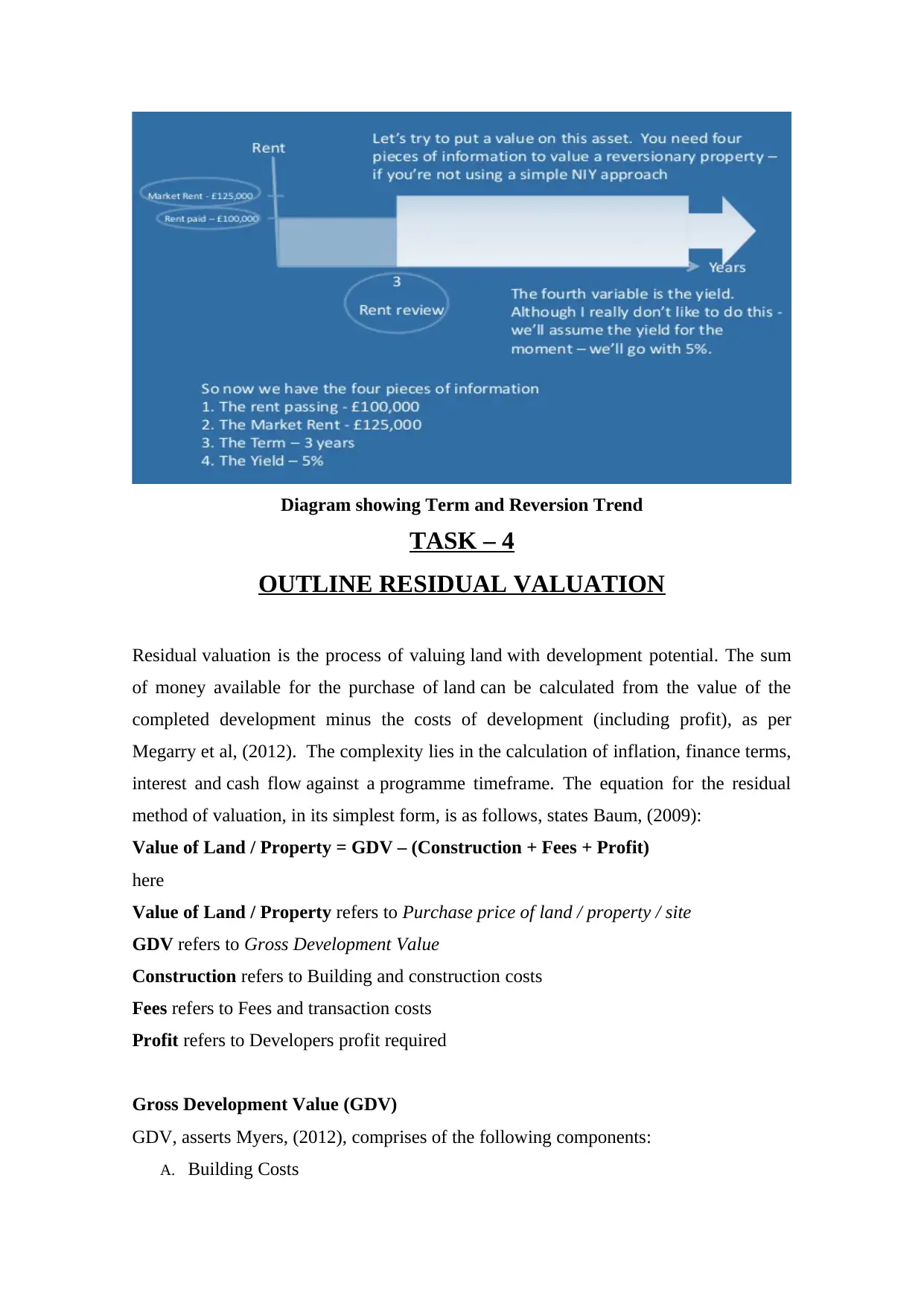
Diagram showing Term and Reversion Trend
TASK – 4
OUTLINE RESIDUAL VALUATION
Residual valuation is the process of valuing land with development potential. The sum
of money available for the purchase of land can be calculated from the value of the
completed development minus the costs of development (including profit), as per
Megarry et al, (2012). The complexity lies in the calculation of inflation, finance terms,
interest and cash flow against a programme timeframe. The equation for the residual
method of valuation, in its simplest form, is as follows, states Baum, (2009):
Value of Land / Property = GDV – (Construction + Fees + Profit)
here
Value of Land / Property refers to Purchase price of land / property / site
GDV refers to Gross Development Value
Construction refers to Building and construction costs
Fees refers to Fees and transaction costs
Profit refers to Developers profit required
Gross Development Value (GDV)
GDV, asserts Myers, (2012), comprises of the following components:
A. Building Costs
TASK – 4
OUTLINE RESIDUAL VALUATION
Residual valuation is the process of valuing land with development potential. The sum
of money available for the purchase of land can be calculated from the value of the
completed development minus the costs of development (including profit), as per
Megarry et al, (2012). The complexity lies in the calculation of inflation, finance terms,
interest and cash flow against a programme timeframe. The equation for the residual
method of valuation, in its simplest form, is as follows, states Baum, (2009):
Value of Land / Property = GDV – (Construction + Fees + Profit)
here
Value of Land / Property refers to Purchase price of land / property / site
GDV refers to Gross Development Value
Construction refers to Building and construction costs
Fees refers to Fees and transaction costs
Profit refers to Developers profit required
Gross Development Value (GDV)
GDV, asserts Myers, (2012), comprises of the following components:
A. Building Costs
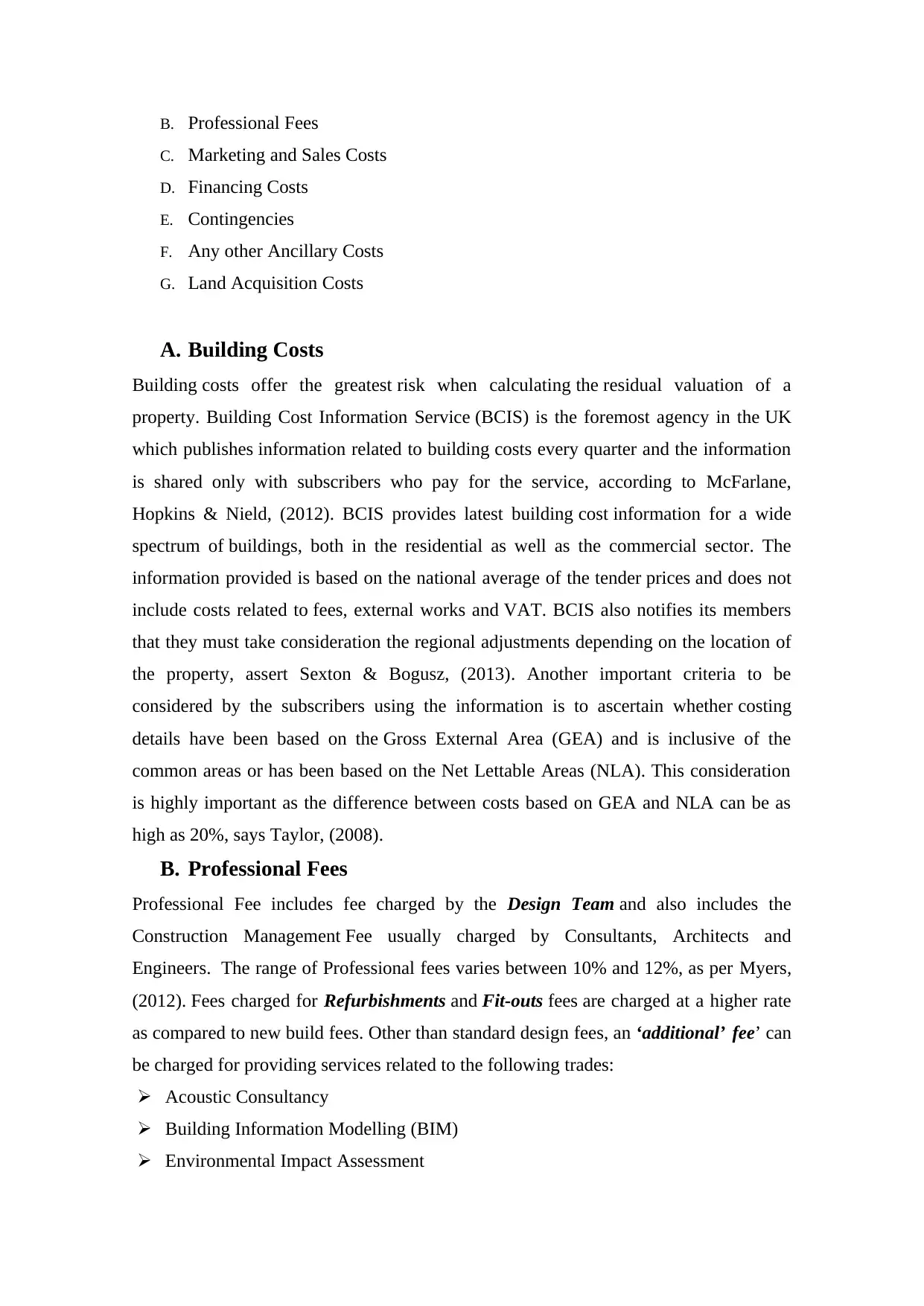
B. Professional Fees
C. Marketing and Sales Costs
D. Financing Costs
E. Contingencies
F. Any other Ancillary Costs
G. Land Acquisition Costs
A. Building Costs
Building costs offer the greatest risk when calculating the residual valuation of a
property. Building Cost Information Service (BCIS) is the foremost agency in the UK
which publishes information related to building costs every quarter and the information
is shared only with subscribers who pay for the service, according to McFarlane,
Hopkins & Nield, (2012). BCIS provides latest building cost information for a wide
spectrum of buildings, both in the residential as well as the commercial sector. The
information provided is based on the national average of the tender prices and does not
include costs related to fees, external works and VAT. BCIS also notifies its members
that they must take consideration the regional adjustments depending on the location of
the property, assert Sexton & Bogusz, (2013). Another important criteria to be
considered by the subscribers using the information is to ascertain whether costing
details have been based on the Gross External Area (GEA) and is inclusive of the
common areas or has been based on the Net Lettable Areas (NLA). This consideration
is highly important as the difference between costs based on GEA and NLA can be as
high as 20%, says Taylor, (2008).
B. Professional Fees
Professional Fee includes fee charged by the Design Team and also includes the
Construction Management Fee usually charged by Consultants, Architects and
Engineers. The range of Professional fees varies between 10% and 12%, as per Myers,
(2012). Fees charged for Refurbishments and Fit-outs fees are charged at a higher rate
as compared to new build fees. Other than standard design fees, an ‘additional’ fee’ can
be charged for providing services related to the following trades:
Acoustic Consultancy
Building Information Modelling (BIM)
Environmental Impact Assessment
C. Marketing and Sales Costs
D. Financing Costs
E. Contingencies
F. Any other Ancillary Costs
G. Land Acquisition Costs
A. Building Costs
Building costs offer the greatest risk when calculating the residual valuation of a
property. Building Cost Information Service (BCIS) is the foremost agency in the UK
which publishes information related to building costs every quarter and the information
is shared only with subscribers who pay for the service, according to McFarlane,
Hopkins & Nield, (2012). BCIS provides latest building cost information for a wide
spectrum of buildings, both in the residential as well as the commercial sector. The
information provided is based on the national average of the tender prices and does not
include costs related to fees, external works and VAT. BCIS also notifies its members
that they must take consideration the regional adjustments depending on the location of
the property, assert Sexton & Bogusz, (2013). Another important criteria to be
considered by the subscribers using the information is to ascertain whether costing
details have been based on the Gross External Area (GEA) and is inclusive of the
common areas or has been based on the Net Lettable Areas (NLA). This consideration
is highly important as the difference between costs based on GEA and NLA can be as
high as 20%, says Taylor, (2008).
B. Professional Fees
Professional Fee includes fee charged by the Design Team and also includes the
Construction Management Fee usually charged by Consultants, Architects and
Engineers. The range of Professional fees varies between 10% and 12%, as per Myers,
(2012). Fees charged for Refurbishments and Fit-outs fees are charged at a higher rate
as compared to new build fees. Other than standard design fees, an ‘additional’ fee’ can
be charged for providing services related to the following trades:
Acoustic Consultancy
Building Information Modelling (BIM)
Environmental Impact Assessment
⊘ This is a preview!⊘
Do you want full access?
Subscribe today to unlock all pages.

Trusted by 1+ million students worldwide
1 out of 21
Your All-in-One AI-Powered Toolkit for Academic Success.
+13062052269
info@desklib.com
Available 24*7 on WhatsApp / Email
![[object Object]](/_next/static/media/star-bottom.7253800d.svg)
Unlock your academic potential
Copyright © 2020–2025 A2Z Services. All Rights Reserved. Developed and managed by ZUCOL.